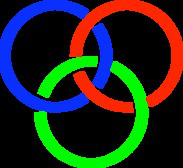Orateur
Prof.
Tobias Frederico
(Instituto Tecnologico de Aeronautica)
Description
The rich nature of quantum few-body systems interacting with
short-ranged forces is not shaped only by three-body properties.
Weakly-bound tetramers composed by identical bosons and their
excited states have a characteristic scale, which is independent of
the trimer one, for resonant pairwise interaction in the unitary
limit (zero two-body binding or infinite scattering length. Such
property can be revealed if one considers the general case, not
constrained by some specific strong short-range interaction. The
existence of an unsuspected new limit cycle is shown through
calculations with Faddeev-Yakubovsky (FY) for a renormalized
zero-range two-body interaction. The new limit cycle is expressed by
an universal function relating the binding energies of two
consecutive tetramer states, $B^{(N)}_4$ and $B^{(N+1)}_4$ (where
for N = 0 we have the ground-state) and the corresponding three-body
subsystem binding energy $B_3$ of an Efimov state [1].
We further derive that the N + 1 tetramer emerges from the 3+1
threshold for a universal ratio $B^{(N)}_4 =4.6\;B_3$, which does
not depend on N. The tetramers move as the short-range four- body
scale is changed. The existence of the new scale can be also
revealed by a resonant atom-trimer relaxation. The resonant behavior
arises when a tetramer becomes bound at the atom-trimer scattering
threshold. Furthermore, the independent four-body scale implies in a
family of Tjon lines in the general case. These findings give
further support in favor of the independent role of a four-body
scale near a Feshbach resonance and its implications for coldatoms.
Furthermore, we will present to some extend the momentum-space
structure of the FY components of weakly-bound tetramers at the
unitary limit [2]. We show that both channels of the FY
decomposition [trimer plus atom (T+A), or $K-$type and dimer plus
dimer (D+D), or $H-$type] present high momentum tails, which
reflects the short-range four-body scale. We also found that the
$H-$channel is favored over $K-$channel at low momentum when the
four-body momentum scale largely overcomes the three-body one.
[1] M. R. Hadizadeh, M. T. Yamashita, Lauro Tomio, A. Delfino, T.
Frederico, Phys. Rev. Lett. (2011); arXiv:1101.0378v1
[physics.atm-clus]
[2] M. R. Hadizadeh, M. T. Yamashita, Lauro Tomio, A. Delfino, T. Frederico, in preparation.
Auteur
Prof.
Tobias Frederico
(Instituto Tecnologico de Aeronautica)
Co-auteurs
Prof.
A. Delfino
(Instituto de Fisica Univ Federal Fluminense)
Prof.
L. Tomio
(Instituto de Fisica Teorica-UNESP)
Dr
M. Hadizadeh
(Instituto de Fisica Teorica-UNESP)
Prof.
M. T. Yamashita
(Instituto de Fisica Teorica-UNESP)

